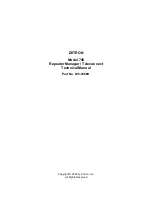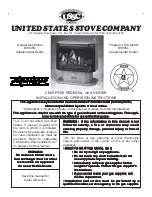
Safety Precautions
General
Information
1. Do not attempt to install, repair, or service this heater
or the gas supply line unless you have continuing
expert training and knowledge of gas heaters.
Qualifications for service and installation of this
equipment are as follows:
a. To be a qualified gas heater service person, you
must have sufficient training and experience to
handle all aspects of gas-fired heater installation,
service and repair. This includes the task of
installation, troubleshooting, replacement of
defective parts and testing of the heater. You must
be able to place the heater into a continuing safe
and normal operating condition. You must
completely familiarize yourself with each model
heater by reading and complying with the safety
instructions, labels, Owner’s Manual, etc., that is
provided with each heater.
b. To be a qualified gas installation person, you must
have sufficient training and experience to handle
all aspects of installing, repairing and altering gas
lines, including selecting and installing the proper
equipment, and selecting proper pipe and tank
size to be used. This must be done in accordance
with all local, state and national codes as well as
the manufacturer’s requirements.
2. All installations and applications of L.B. White heaters
must meet all relevant local, state and national codes.
Included are L.P. gas, natural gas, electrical, and
safety codes. Your local fuel gas supplier, a local
licensed electrician, the local fire department or
similar government agencies, or your insurance agent
can help you determine code requirements.
a. For U.S.A. installations and applications:
-- ANSI/NFPA 58, latest edition, Standard for
Storage and Handling of Liquefied Petroleum
Gas and/or
-- ANSI Z223.1/NFPA 54, National Fuel Gas Code
-- ANSI/NFPA 70, National Electrical Code.
b. For Canadian Installations and Applications:
-- CAN1-B149.1 or CAN1-B149.2 Installation
Codes
-- CSA C22.1 Part 1 Standard Canadian Electrical
Code. CSA C22.2 No. 3, Electrical Features of
Fuel-Burning Equipment.
3. Do not move, handle, or service heater while in
operation or connected to a power or fuel supply.
4. Observe and obey all instructional warnings pertaining
to cleaning procedures located on each heater.
5. For safety, this heater is equipped with a manual reset
high-limit switch and where applicable, an air proving
switch. Never operate this heater with any safety
device that has been bypassed. Do not operate this
heater unless all of these features are fully
functioning.
6. Do not operate the heater with its door open or panel
removed.
7. Do not locate fuel gas containers or fuel supply hoses
anywhere near the blower outlet of the heater.
8. Do not block air intakes or discharge outlets of the
heater. Doing so may cause improper combustion or
damage to heater components leading to property
damage or animal loss.
9. The hose assembly shall be visually inspected on an
annual basis. If it is evident there is excessive
abrasion or wear, or if the hose is cut, it must be
replaced prior to the heater being put into operation.
The hose assembly shall be protected from animals,
building materials, and contact with hot surfaces
during use. The hose assembly shall be that specified
by the manufacturer. See parts list.
10. Check for gas leaks and proper function upon heater
installation, before building repopulation or when
relocating.
11. This heater should be inspected for proper operation
by a qualified service person before building
repopulation and at least annually.
12. Inform the customer to always turn off the gas supply
to the heater if the heater is not going to be used in
the heating of livestock.
13. This heater is equipped with a three-prong (grounding)
plug for your protection against shock hazard and
must be plugged directly into a properly grounded
August 1999
1.3-2
2







































